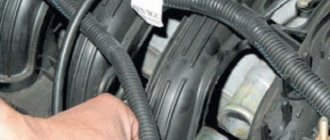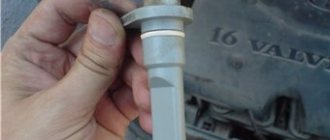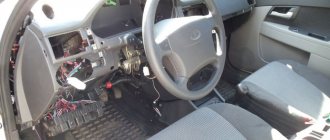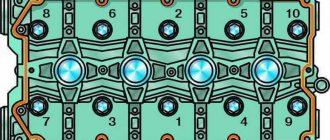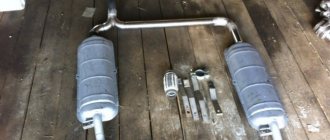| The engine cooling system (ECS) is one of the main systems of a car. Is the heater on your LADA Priora not working well or is the engine overheating? Then the inspection should begin with this system. In this article you will find all the information on the operation of the Lada Priora cooling system. |
Signs that indicate the need to replace a part
Experts believe that the main factors that indicate a faulty water pump are:
- coolant leaking from the housing in the oil seal area;
- wear of the built-in bearing, which is determined by increased noise, humming during operation, or jamming;
- insufficient circulation of the coolant used;
- excessive increase in the temperature of the power unit;
- reducing the level of coolant poured into the system;
- the presence of cracks, chips, chipping of the material of the pulley, housing or impeller of the water pump.
The water pump, as a rule, is a non-repairable component due to its design features
Therefore, experts recommend a complete replacement of this important part.
The water pump for the Lada Priora is completely replaced if it malfunctions
Briefly about the main thing
The first step is to decide why there is pressure in the cooling system. It would seem that the banal circulation of coolant should be enough to remove heat. This used to happen when water was poured into the radiator. But it was also common to come across a car on the side of the road with steam pouring out from under the hood. This happened because the water did not have time to cool, and since its boiling point is 100 degrees, it boiled very quickly.
Modern antifreezes, most of which are alcohol-based, boil at approximately 115 degrees Celsius. But it’s worth remembering the school physics course, where you can learn that an increase in pressure leads to a shift in the boiling point of the liquid. This also applies to antifreeze that circulates through internal combustion engine systems.
Installation instructions for an additional electric pump
Communities Lada Priora Lada Priora Club Blog Micro FAQ 2. Checking the functionality of the expansion tank cap
Installing an additional water pump on any car (including the Lada Priora has 16 valves) is basically no different. It is necessary to place the electric pump in the section of the pipe, which is the input or output to the car’s stove and provide its power supply.
Step-by-step instructions for installing this additional component are as follows:
- Provide access to the heater pipes under the hood of the car by removing components that interfere with operation.
- Compress one of the rubber pipes that comes out of the heater (stove), which is done to prevent coolant from leaking out, or drain antifreeze (antifreeze) from the entire system.
- Cut part of this pipe to the length of the corresponding pump being installed.
- The length of the fittings is not taken into account due to the fact that they fit into the pipes.
- It is necessary to select the diameter of the fittings on the electric pump in advance to obtain a high-quality connection.
- Secure the rubber pipes to the pump fittings using metal clamps.
- Attach the additional electric pump to a pre-selected location under the hood of the car (indicated above) using special fasteners.
- Connect the power supply to the pump by selecting the options listed above, or install a separate switch.
- Start the engine and check the tightness of the connections, as well as the functionality of the electric pump.
- Install all parts that were removed before installing the pump.
VAZ 2110 /2001/: modification of the cooling system dozens
This review is not exactly what we are used to seeing here, but I think the information contained in it will help some of the “ten” owners.
VAZ cars of the 10th family are very common in Russia and the CIS countries. Like all domestic cars, they suffer from a whole host of “congenital diseases”. Here’s one common “illness”: “antifreeze keeps leaking somewhere. " and "the expansion tank cracks all the time." Yes, I heard, and in the new Kalinas “the antifreeze goes somewhere.” To be honest, diagnosing this “illness” was difficult, but instructive.
The first thing any reasonable driver (and even a car mechanic) considers is the expansion tank and the hoses suitable for it. And after the first inspection he makes a diagnosis - the expansion tank is leaking and needs to be replaced. And indeed, it is very wet around the tank. We change. But the problem remains. However, the tanks are bad.
One day I noticed that the “tank leaks” only if the electric radiator fan was turned on while driving. Strange conclusion. But it's a fact! And even stranger, the tank does not leak if the heater is on. Even stranger. I decided to watch this process. I started the engine and, opening the hood, left it running at idle, and even in hot weather. After a few minutes, the tank began to “leak”, and so much! And then, after about three seconds, the electric radiator fan turned on. And the “leakage” of the tank stopped.
The problem was that the engine simply boiled, and the steam expelled the liquid into the expansion tank, where, under the pressure of this steam, the relief valve in the tank lid opened. And through this valve the pressure expelled the liquid out. Then, when the radiator fan turned on, the temperature in the system quickly dropped and the boiling stopped. The result is that a glass of antifreeze is gone.
Everything is obvious - the fan turns on too late, when the coolant has already reached the boiling threshold.
Of course, having experience in operating the Moskvich-2141, VAZ-21099, I naively thought that the thermocouple sensor on the radiator, which in these cars turns on the fan when the liquid in the radiator is heated, was not working well. But it took me about an hour to search fruitlessly for this sensor on the “ten” radiator. It turns out that the “top ten” simply does not have this sensor, and the decision whether to turn on the radiator fan or not is made by the on-board computer, mainly focusing on the engine temperature indicator sensor. Like this!
Well, the temperature sensor of the temperature indicator may be faulty. I'm changing it. Again the result is a complete “logical zero”.
Since the owner, my relative, needed the car very badly and urgently, I had to build a temporary circuit to manually turn on the fan. Gave instructions to the owner, “As soon as there is more than 90°, turn on the “arrow”! And drive like that, and when it drops below 90°, turn it off. The next day the happy owner almost kissed me with joy that “the tank is no longer cracking” and “the antifreeze is not leaking.”
But practically the problem was not solved, and we had to return to it later. Apparently the idiotic computer firmware is to blame, which turns on the fan too late. As a result, the pressure in the system increases and either antifreeze flows out through the valve on the cap of the expansion tank, or the tank bursts. Of course, the optimal solution is to change the firmware. But changing the firmware can also affect other parameters of the machine. And everything except antifreeze was in order - good efficiency, sufficient agility of the car, easy starting in winter. No, they decided not to change the firmware, but to try to deceive the computer by connecting a constant resistor in parallel with the temperature sensor, so that the computer “thinks” that the temperature is 10 percent higher than it actually is. I began to conduct experiments with the sensor and found that in order for the fan to turn on before the liquid boils, you need to turn on a 9.1 kOhm resistor in parallel with it.
So I did. While it was hot, everything was fine, but in our northern latitudes in the summer it can be +30°C during the day, and at night there can be frosts down to 0°C. On such a frosty summer night, the car would not start until the resistor was turned off.
As they say, I had to go back to the drawings. The resistance of the temperature sensor at room temperature is 2.5 kOhm; if it is placed in a refrigerator on ice, the resistance increases to 9-10 kOhm. In boiling water – 0.5 kOhm. So it turns out that by connecting 9.1 kOhm in parallel, we lower the “hot” resistance by about 5%, but the cold one by as much as 60%. Therefore, on a cold engine, the computer “thinks” that the engine is warm enough and does not take measures for a cold start.
Of course, a radical measure could be to replace the VAZ-2110 radiator with a VAZ-2108 radiator with a fan-on thermocouple sensor installed on it. But this is too costly and labor-intensive.
In general, I had to leave the thermal sensor alone and go a different way. I disconnected the fan relay winding from the computer and instructed it to be controlled by a simple homemade thermostat, the diagram of which is shown in the photo.
Thermistor R2 is the second temperature sensor, which we bought in vain, thinking that the standard one was faulty. The working cylinder of the temperature sensor was thickly coated with heat-conducting paste and clamped to the metal of the car radiator. Then I spread even more heat-conducting paste on top of it.
The switch-on temperature is controlled by variable resistor R3. This should be a multi-turn variable resistor. Resistor R4 must be selected according to the required hysteresis.
Relay K1 is a standard fan switch relay; it is completely disconnected from the computer. Or you can use an additional relay.
Instead of the KR140UD608 op amp, you can use any general purpose op amp.
I sent a more detailed version of this article to the Radioconstructor magazine, they promised to publish it in No. 7 for 2010.
When to replace
Communities Lada Priora Lada Priora Club Blog what affects the clutch release limit switch
The frequency of fluid replacement in Priora models that were released after 2011 is approximately seventy-five thousand kilometers. After this period, antifreeze loses its functional properties. This is only true for the product provided by the original manufacturer. If you use Antifreeze, it will last half as long.
The need to replace the coolant can be determined by the following symptoms:
- the appearance of dirt, uncharacteristic marks, lumps of thickened liquid;
- antifreeze has begun to leak out - it can be replenished, but if you do not know the exact brand, it is recommended to replace it;
- there are deposits and dirty traces in the container, which indicates the need for an urgent replacement of the fluid, which has lost its performance properties;
- under the hood foam appears in the reservoir intended for storing fluid;
- reduction in the quality of operation of the air heating stove;
- The motor heats up at a high speed.
Possibility of installing an additional water pump on the Lada-Priora
One of the disadvantages of the heater on the Lada Priora car is its low efficiency when the engine operates at low speeds in the cold season, due to insufficient coolant circulation. Therefore, the car interior warms up slowly and insufficiently, which causes some discomfort for the driver and passengers.
There are some requirements that must be met to obtain a high-quality result after installing an additional electric pump.
These include the following points:
- the installed product should not create excess pressure in the heater radiator during operation in order to avoid damage to the pipes or the formation of cracks;
- It makes sense to replace the thermostat and install this component with an increased opening temperature (90–95 degrees Celsius) due to the fact that as the speed in the coolant circulation increases, the engine parts will warm up more slowly, increasing wear on the power unit.
To solve this problem, you can install an additional water pump in the cooling system of the power unit, which will qualitatively improve the heating of the car interior even when the engine is idling. This technology is not new. Engineers have been using it for a long time. Examples include German cars BMW or Mercedes Benz.
Device selection
As a rule, devices from various manufacturers are suitable as an additional water pump for the Lada-Priora car.
These, for example, could be brands from:
- Bosch company;
- ;
- .
Video: positive effect of installing an additional electric pump on the Lada Priora
However, most often the Lada Priora is equipped with an electric water pump, which is installed on Gazelle cars. This may be an old or new design, but the principle of operation is the same for both: due to the vacuum at the inlet during operation of the product, a pumping force arises, which drives the coolant through the system. In fact, the pump from the Gazelle car is a classic centrifugal pump.
The design of the new pump version is much more successful and causes fewer complaints from car enthusiasts. And it is also less noisy during operation. The main problem that motorists encounter when using such an electric pump is its leakage.
Installation and connection of an additional electric pump
To equip a car with an additional electric water pump, you will also need a regular relay that has normally open contacts (this can be an ignition or starter relay from a VAZ 2105, VAZ 2108). It is necessary to close contacts No. o86 and No. o30. And you will also need a reinforced hose and clamps for clamping the pipes.
An additional pump can be installed in any of the gaps in the supply or outlet pipes of the car’s heating stove.
Installation of an additional electric pump is quite simple, and the efficiency of the heater increases significantly
The pump is fixed in the Lada Priora in the following places:
- stud for fastening the washer reservoir;
- studs located next to the battery;
- on the engine shield.
The device can be connected to a wide variety of systems.
It could be:
- recirculation button;
- SAUO stove block;
- heated mirrors;
- other convenient places.
General information
On Priora and Kalina there is a fan that acts as the main cooling system. It is necessary to prevent overheating and ensure stable operation of the internal combustion engine (ICE). The main element for cooling the power unit is the sensor. Using its signal, the fan is activated.
In cars, this unit is triggered in cases where the thermal performance of the engine exceeds the norm. After starting the fan, which is located near the engine and is triggered by a signal from the controller, the temperature of the internal combustion engine drops to an acceptable level.
Important! The ventilation device does not turn on in cases where the sensor does not produce a signal. This leads to overheating of the engine.
Temperature sensor malfunction
The reason that the liquid in the cooling system, which serves as an air conditioner for the car's power plant, does not heat up or overheats is due to the failure of the temperature sensor.
Often signs of such a malfunction are:
- Stopping the flow of warm air into the car interior, which occurs due to the cessation of fluid flow into the heater.
- Dark, almost black smoke comes out of the exhaust pipe. This indicates engine detonation, which was a result of overheating.
- Engine power drops sharply.
Many drivers quickly stop the car when it overheats and turn off the engine. In fact, an immediate stop of the machine is required only if the tightness of the system is broken and liquid pours out of it. In other situations, the driver must perform the following actions:
- turn on the heating to maximum so that the fluid temperature drops and the engine cools down quickly;
- drive smoothly to the side of the road;
- Let the engine idle for 2-3 minutes with the heating system on.
After this, the engine must be turned off and allowed to cool for 20 minutes. After this, you need to measure the fluid level in the cooling system and add it if necessary. Immediately after the engine is turned off, you cannot open the radiator cap, as you can get burned from contact with the liquid. If the fluid level is normal, then the cause of overheating must be determined by diagnostics. To do this you will have to visit a car service center.
Removal methods
Now let’s move on directly to how to remove the formed air plug from the cooling system without resorting to the help of specialists.
I can offer 3 methods in total. Each of them has its own characteristics and can be used for certain cars. Therefore, think carefully before settling on one of the methods.
First method
This option is suitable for owners of VAZ cars, including:
- VAZ 2107;
- 2110;
- VAZ 2114;
- 2109;
- VAZ 2115;
- Lada Kalina;
- Priora;
- Lada Granta;
- VAZ 2111;
- VAZ 2108, etc.
If you have just such machines, then you can safely get to work.
The procedure looks like this:
Access to the tank where the coolant is located opens. It is necessary to remove the security elements; Now one of the 2 pipes that go to heat the throttle is turned off
It doesn’t matter which pipe to disconnect; Remove the lid from the tank and cover the hole with a low-density rag; Blow into the reservoir to create excess pressure. You should blow until air comes out of the nozzle; Coolant should leak out soon
At this moment you need to secure the pipe with a clamp. Here it is worth turning to a friend for help; If the pipe is not secured, a new plug may appear; Return all elements to their place; Start the engine and you can drive for a couple of kilometers.
In theory, the symptoms of malfunctions should disappear. Just keep in mind that the method is suitable specifically for domestic cars, since it is possible to disconnect the pipe on them.
Second method
If the first option for removing air pollution does not suit you, I suggest using the second method.
Here the procedure is carried out like this:
- Start the engine at idle;
- Let it run for 10-15 minutes;
- Turn off the engine;
- As in the previous instructions, remove the protective elements;
- Open access to the tank;
- Remove only 1 pipe;
- The coolant will circulate throughout the system;
- The air will begin to escape without your participation;
- When the antifreeze starts to come out, the pipe returns to its place.
The method is frankly not bad. But there is one drawback. It consists in the high temperature of the pipes. It is strongly not recommended to handle them with bare hands.
Turn on the heater and check whether the proper volume of hot air begins to flow into the cabin. If yes, everything went well, and therefore you can enjoy the result of your own repair. The job is no more difficult than bleeding the clutch.
Third method
It is considered the most difficult because you will need a jack or some kind of inclined surface to work.
You need to act in the following sequence.
The car is placed on a jack to raise the front end higher than the rear of the car; It is important that the radiator cap is higher than other system components; Be sure to turn on the handbrake; Start the engine and let it idle; After 15 minutes, start working if the temperature has approached the operating parameters for the internal combustion engine; The covers are removed from the radiator cap and coolant reservoir; Smoothly press the gas pedal, gradually increasing the speed; At the same time, the assistant must add coolant to the reservoir; If bubbles are visible, the cork is coming out; Start the heater and continue pouring coolant; When you feel hot air in the cabin and the bubbles run out, the plug has come out
You can’t handle this yourself, so you’ll have to call an assistant. You should also carefully add coolant so as not to provoke the formation of a new plug. Always top up the coolant that is currently in the expansion tank. I have already told you separately about mixing antifreeze.
Thank you all for your attention! Subscribe, be sure to ask questions and invite your friends to join us!
33,67
How to choose a coolant
Answering the question of what antifreeze to use in Priora, the manufacturer did not provide a large assortment to its users. It is best to use the Felix-40 cooler. You can use other brands, but this is not recommended. The engine system may wear out in a shorter period of time. As a result, you will have to contact the service for global repairs and replacement of parts.
If you are using antifreeze from another manufacturer, it is recommended to study its characteristics. It must meet international quality standards.
How to check the fluid level and how much will be enough?
To determine how many liters of coolant are needed to fill the tank, carefully read the vehicle's owner's manual. You will need approximately 7.8 liters. Some car owners prefer to fill a little less - 6 liters.
You can check the antifreeze level in the tank even on a cold engine. To do this, lift the hood lid. You will see a tank. There are two marks on it with a maximum and a minimum value. The fluid level must be within these marks.
Operating temperature of the Lada Priora engine 8 and 16 valves characteristics
A car engine is equipped with a cooling system that contains liquid. The temperature of this liquid is measured by a sensor. This value that it records is the engine operating temperature (ERT). The data recorded by the sensor is displayed on the dashboard. The average operating temperature of a Priora car engine is 95 degrees. This indicator is optimal when the car is moving at a speed of approximately 70-80 km/h and provided that the ambient temperature is not higher than +20 degrees. When the liquid heats up to 100 degrees, the fan turns on, which is designed for additional cooling. With such indicators, it is time to say that the power plant of the machine is functioning without failures. In winter and summer, the RTD may be different. Which RTD is considered optimal for this car? The average is 85-90 degrees.
If the fan does not turn on
If the RTD has risen to 100 degrees and the indicator needle has entered the red part of the scale, this indicates overheating. Perhaps this phenomenon occurred due to the fact that the fan did not work. If you find that when it overheats, the fan does not start working and the temperature does not drop, you need to check the serviceability of the fan itself. It is necessary to determine whether the switch-on sensor is triggered when the normal RTD is exceeded? First, start the engine and disconnect the wires from the temperature sensor that is installed on the engine. When the wires are disconnected, forced cooling should work. If this does not happen, most likely the fault lies in the electric motor of the device. How to check the operation of the fan, watch the video.
If the fan turns on after disconnecting the wires, it means there is a problem with the fan switch sensor. Perhaps it incorrectly perceives data about the RTD and therefore does not operate at the right time.
This malfunction is quite easy to fix: you just need to replace the sensor. After replacing it, check if the fan turns on. To do this, start the engine. When the RTD reaches normal levels, do not turn off the engine until the temperature exceeds the norm. As soon as this happens, the fan should be activated. If the fan operates at a temperature above 97 degrees, but less than 100 degrees, then the system is functioning properly.
Temperature sensor malfunction
The reason that the liquid in the cooling system, which serves as an air conditioner for the car's power plant, does not heat up or overheats is due to the failure of the temperature sensor.
Often signs of such a malfunction are:
- Stopping the flow of warm air into the car interior, which occurs due to the cessation of fluid flow into the heater.
- Dark, almost black smoke comes out of the exhaust pipe. This indicates engine detonation, which was a result of overheating.
- Engine power drops sharply.
Many drivers quickly stop the car when it overheats and turn off the engine. In fact, an immediate stop of the machine is required only if the tightness of the system is broken and liquid pours out of it. In other situations, the driver must perform the following actions:
- turn on the heating to maximum so that the fluid temperature drops and the engine cools down quickly;
- drive smoothly to the side of the road;
- Let the engine idle for 2-3 minutes with the heating system on.
After this, the engine must be turned off and allowed to cool for 20 minutes. After this, you need to measure the fluid level in the cooling system and add it if necessary. Immediately after the engine is turned off, you cannot open the radiator cap, as you can get burned from contact with the liquid. If the fluid level is normal, then the cause of overheating must be determined by diagnostics. To do this you will have to visit a car service center.
Device and features
The cooling system of the Priora internal combustion engine has a standard set of main components:
- radiator;
- thermostat;
- electric fan;
- water pump;
- heater;
- engine jacket;
- connecting hoses;
- expansion tank.
By circulating through the large and small circuits, the coolant prevents the engine from overheating, maintaining the desired temperature. Structurally, the cooling system of the Priora is simple and no different from other internal combustion engines with an injector, with the exception of small parts.
Radiator and forced cooling fan
They mainly serve to bring the working fluid to the optimal temperature for the functioning of the engine (the operating temperature of the Priora engine with 16 valves is 90–95 degrees). The predecessor of the Priora VAZ 2110 often installed a cooler made of copper alloys, but due to cheaper prices, designers switched to aluminum analogues.
The operation of the fan depends on the engine control unit.
It receives information from the DTOZH (this is a sensor that reads temperature readings) located in the water jacket of the power unit. If the permissible temperature values are exceeded, the control unit connects an electric fan to improve cooling efficiency. A faulty fan or clogged radiator can lead to a constant increase in optimal engine temperatures, which shortens the service life and can cause costly repairs.
Thermostat
Its task is to promptly open coolant access to a large circle of the engine cooling system (engine cooling system) after the engine reaches the optimal temperature. In simple terms, the thermostat allows you to quickly warm up the engine and regulates the operation of the entire system. During warming up, the thermostat valve is in the closed position, antifreeze does not flow through the large circuit (the radiator is not activated). As it warms up, the valve opens slightly under the influence of rising temperature, and antifreeze begins to move through the radiator along a larger circuit.
A thermostat malfunction can result in overheating of the power unit (if the valve is stuck closed) or, conversely, the operating temperature rises very slowly (when the valve is stuck in the open position). Overheating is much more dangerous. Beginners can identify this malfunction if the engine heats up all the time and the fan on the Priora is constantly running.
Pump (water pump) and heater
Without the first part, the coolant circulation circuit in the system is impossible. If the water pump is faulty, at best there will be a coolant leak from the system. In the worst case, the pump may jam, which will lead to a broken timing belt and subsequent problems, the solution of which will result in expensive repairs.
The heater, or simply the stove, consists of a radiator, pipes and a fan. Can additionally cool the antifreeze in the system. An indispensable unit in winter. Provides the interior with warm air.
Connecting elements and expansion tank
It serves as a receiving compartment where gases and vapors are discharged when the coolant is heated. Also, the expansion tank is the level for the entire cooling system. One of the main elements in the tank is the valve cover through which air is forced out. There is antifreeze, it begins to boil when the engine temperature rises critically.
The design of the cooling system also includes an engine temperature sensor on the Priora and an engine jacket. The sensor constantly reads information about the current antifreeze temperature and transmits it to the ECU. The location of the power plant jacket is structurally assumed in the cylinder block housing; it serves to remove heat through the coolant.
Preparatory stage
Before you start, you should do the following:
- choose and buy a suitable cooler;
- stock up on a new cover mount in case the old one is damaged;
- take the wrench;
- find a container where you will send the waste liquid;
- buy rags.
Algorithm of actions
To replace antifreeze in Priora, follow the instructions:
- Send the car to a garage with plenty of free space to work on. Cool down the engine. All actions must be performed on a cold engine system.
- Get rid of high blood pressure. Open the cap of the reservoir containing the antifreeze. If the engine is hot, fluid may splash out. Use a cloth and gloves for protection.
- Remove the protection that is installed on the propulsion system. Unscrew the bolts on the mount. The latches do not need to be removed. They will not interfere with the process.
- If a transmission with cables is installed, it must be removed. To do this, disconnect power from the battery. Remove the protective coating with a wrench.
- Now you need to drain the entire volume of liquid. To do this, unscrew the fixing cap. Place a container below where the waste material will be drained. Wait until all the refrigerant has left the tank. Assess the condition of the latch. If signs of wear are noticeable, replacement is recommended.
- If there are any cloudy traces in the coolant, it is recommended to flush all the channels in the car. To do this, add purified water. Add citric acid or vinegar to remove any remaining dirt. Flush the system until the water runs clear. Only after this can you fill the coolant into the tank.
- Assess the condition of the hoses. If they are worn out, replace them.
- Using a hose, pour new fluid into the container. Avoid high internal pressure.
- Refrigerant is added until the tank is filled to the optimum level.
- All disassembled parts are reassembled in reverse order.
- Start the engine and take it for a test drive. After this, check if all systems are normal.
Is it possible to mix antifreeze?
Please note that antifreeze and antifreeze cannot be mixed under any circumstances - these are different types of coolant. Otherwise, the mixing “scheme” may resemble the blood transfusion scheme:
- G11 can be mixed with analogues G11, G12+, G12++, G Cannot be mixed with G12.
- G12 can be mixed with G11, G12+. Cannot be mixed with G11, G12++, G
- G13, G12++ and G12+ can be combined, mixing one type with another.
The type of coolant is written on the packaging - this is the letter G with a two-digit number and pluses, or TL - this is how antifreeze is designated.
Description
A complete set of pipes for the 21126 Priora engine solves the problem of selecting and finding the necessary pipes for replacement.
Material: reinforced rubber (2-layer).
Size: wall thickness 4 mm.
Advantages: reliability and aesthetic appearance.
1.2170-1303025-10A-sport = Radiator inlet pipe = 1 piece;
2.2112-1014056A-sport = Breather pipe = 1 piece;
3.2170-1303010-10A-sport = Radiator outlet pipe = 1 piece;
4.2112-1148035A-sport = Air filter pipe = 1 piece;
5.2112-1014058A-sport = Breather pipe (analogue 21124) = 1 piece;
6.2170-1303080A-sport = Expansion tank pipe = 1 piece;
7.2170-8101200A-sport = Heater supply pipe = 1 piece;
8.2170-8101208A-sport = Heater outlet pipe = 1 piece;
9.2112-1008658A-sport = Red plate bushing = 4 pcs
You can pay for your purchase in any convenient way:
- VISA, MasterCard (no commission)
- Receipt for payment
- Sberbank Online
We deliver goods throughout Russia and Kazakhstan
We can send your purchase to you by transport company:
Lower breather hose for VAZ 2110-2112, Lada Priora, Kalina, Granta
Blue silicone radiator pipes for Lada Priora
Red reinforced rubber radiator pipes for Lada Priora
Blue silicone hose 1 meter diameter 20 mm
Heater pipes reinforced rubber red for Lada Priora
Blue silicone heater pipes for Lada Priora
Blue silicone hose 1 meter diameter 8 mm
Thermostat pipe injector corner for VAZ 2108-21099, 2110-2112, 2113-2115, Priora
Filling pipe for the cooling system of the expansion tank on Lada Priora
Air intake of OAT air filter for Lada Priora
Small outlet pipe for the heater in the passenger compartment on Lada Priora
Lower radiator outlet hose (pipe) for 16 cells VAZ 2110-2112, Lada Priora
Heater supply pipe (to the engine compartment, long) on Lada Priora
Cold air intake pipe for Lada Priora with air conditioning
Water pump supply pipe for VAZ 2110-2115, Lada Priora, Vesta, X-Ray
Upper radiator hose (pipe) supplying 16 cells VAZ 2110-2112, Lada Priora
Lower radiator outlet pipe for Lada Priora with air conditioning
Upper radiator supply pipe for Lada Priora with air conditioning
Upper crankcase exhaust ventilation hose (pipe) Forward Automatic spare part for VAZ 2110-2112, Lada Priora sedan
Set of engine pipes silicone blue cs20 profi for Lada Priora
Expansion tank hose to thermostat Forward Auto spare part for Lada Priora sedan
Radiator pipes for Lada Priora
Pneumatic drive system hose (long) for Lada Priora, Kalina 2, Granta, Vesta
Lower crankcase ventilation hose a-sport for Lada Priora, Kalina 2, Granta, Vesta
Set of heater pipes for Lada Priora
Water pump supply pipe for Lada Kalina, Priora sedan, Granta sedan, Vesta, X-Ray, Datsun
Breather pipe (hose) Forward Auto spare part for VAZ 2110, Lada Priora sedan
Lower radiator outlet hose (pipe) Forward Auto spare part for Lada Priora
Radiator upper supply pipe Forward Auto spare part for Lada Priora
The internal structure of a car is a very complex combination of functions and devices, the functionality of which is ensured by various systems. One of these is the cooling system (SOD), which regulates the temperature both under the hood and inside the car during hot periods.
And, of course, over time or when overloaded, some parts of this system fail, leading to serious consequences, and this is partly true for everyone’s favorite Lada Priora. Therefore, if you notice poor performance of the stove or overheating of the engine, the first thing you need to do is check the ODS.
Often the problem lies in the hoses or pipes of the system, which could “come off” or become leaky. This is not the worst problem, which can be solved by simply purchasing new (ideally silicone) parts and installing them. It is these hoses and pipes, as well as those made of reinforced rubber, that you will find on this page of our store and can be purchased with the necessary help from our consultants.
Engine operating temperature
We have learned the resource, now we move on to another important indicator. The optimal operating temperature is 90-95°C
After 97°C, engine number 126 with 16 valves will “slow down” a little, but according to the rules, temperatures up to 100°C are considered normal. If the Lada unit is operated with this indicator, then you need to be sure that the radiator fan is running at this time. When you see an indicator below +90°C on the dashboard, you need to assume that this is underheating. Of course, in cold weather the power plant needs more time for the temperature to reach normal levels.
Remember:
- Operating temperature – 90-95°C.
- Normal temperature (engine runs worse) is 97-110°C.
- Reduced temperature – 90°C and below.

